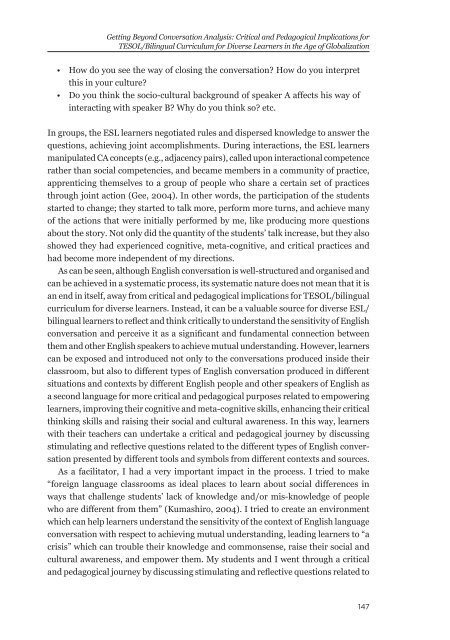Download issue - Umeå universitet
Download issue - Umeå universitet
Download issue - Umeå universitet
Create successful ePaper yourself
Turn your PDF publications into a flip-book with our unique Google optimized e-Paper software.
Getting Beyond Conversation Analysis: Critical and Pedagogical Implications for<br />
TESOL/Bilingual Curriculum for Diverse Learners in the Age of Globalization<br />
• How do you see the way of closing the conversation How do you interpret<br />
this in your culture<br />
• Do you think the socio-cultural background of speaker A affects his way of<br />
interacting with speaker B Why do you think so etc.<br />
In groups, the ESL learners negotiated rules and dispersed knowledge to answer the<br />
questions, achieving joint accomplishments. During interactions, the ESL learners<br />
manipulated CA concepts (e.g., adjacency pairs), called upon interactional competence<br />
rather than social competencies, and became members in a community of practice,<br />
apprenticing themselves to a group of people who share a certain set of practices<br />
through joint action (Gee, 2004). In other words, the participation of the students<br />
started to change; they started to talk more, perform more turns, and achieve many<br />
of the actions that were initially performed by me, like producing more questions<br />
about the story. Not only did the quantity of the students’ talk increase, but they also<br />
showed they had experienced cognitive, meta-cognitive, and critical practices and<br />
had become more independent of my directions.<br />
As can be seen, although English conversation is well-structured and organised and<br />
can be achieved in a systematic process, its systematic nature does not mean that it is<br />
an end in itself, away from critical and pedagogical implications for TESOL/bilingual<br />
curriculum for diverse learners. Instead, it can be a valuable source for diverse ESL/<br />
bilingual learners to reflect and think critically to understand the sensitivity of English<br />
conversation and perceive it as a significant and fundamental connection between<br />
them and other English speakers to achieve mutual understanding. However, learners<br />
can be exposed and introduced not only to the conversations produced inside their<br />
classroom, but also to different types of English conversation produced in different<br />
situations and contexts by different English people and other speakers of English as<br />
a second language for more critical and pedagogical purposes related to empowering<br />
learners, improving their cognitive and meta-cognitive skills, enhancing their critical<br />
thinking skills and raising their social and cultural awareness. In this way, learners<br />
with their teachers can undertake a critical and pedagogical journey by discussing<br />
stimulating and reflective questions related to the different types of English conversation<br />
presented by different tools and symbols from different contexts and sources.<br />
As a facilitator, I had a very important impact in the process. I tried to make<br />
“foreign language classrooms as ideal places to learn about social differences in<br />
ways that challenge students’ lack of knowledge and/or mis-knowledge of people<br />
who are different from them” (Kumashiro, 2004). I tried to create an environment<br />
which can help learners understand the sensitivity of the context of English language<br />
conversation with respect to achieving mutual understanding, leading learners to “a<br />
crisis” which can trouble their knowledge and commonsense, raise their social and<br />
cultural awareness, and empower them. My students and I went through a critical<br />
and pedagogical journey by discussing stimulating and reflective questions related to<br />
147

















